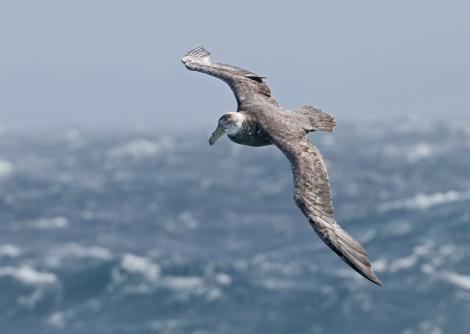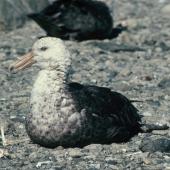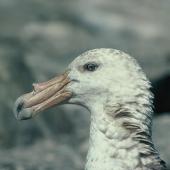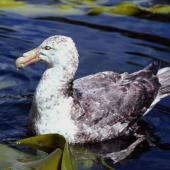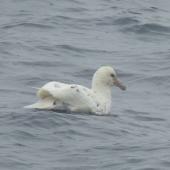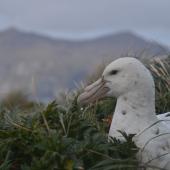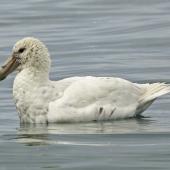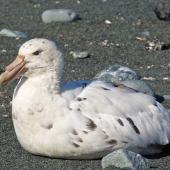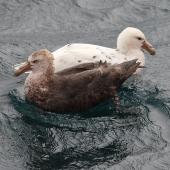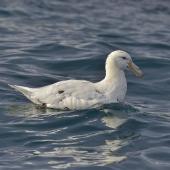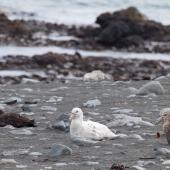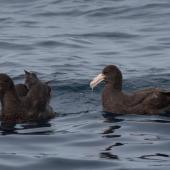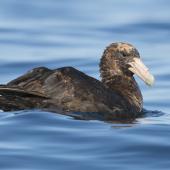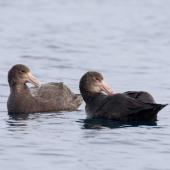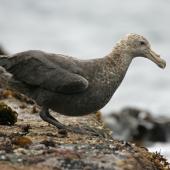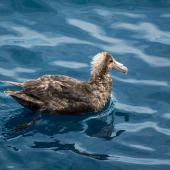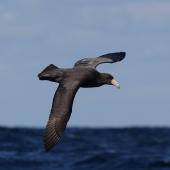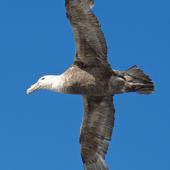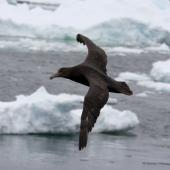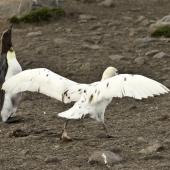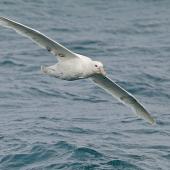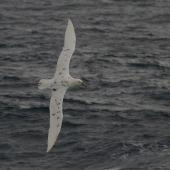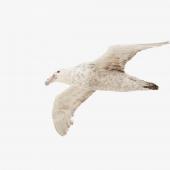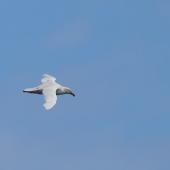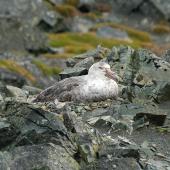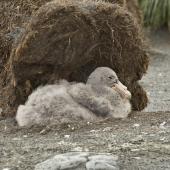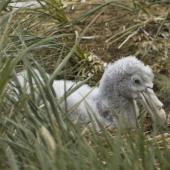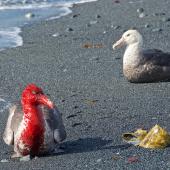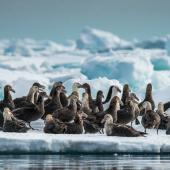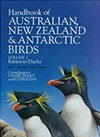Southern giant petrel | Pāngurunguru
Macronectes giganteus (Gmelin, 1789)
Order: Procellariiformes
Family: Procellariidae
Other names: nelly, stinker, pangurunguru, giant fulmar, glutton, stinkpot, sea vulture
Geographical variation: Nil
Giant petrels are large fulmarine petrels, the size of a mollymawk, with a large wingspan and huge bill. Although they resemble mollymawks and albatrosses, they are more closely related to five smaller fulmarine petrel species, including the Antarctic fulmar, Cape petrel and snow petrel. They have two large tube nostrils that are joined together on the top of the huge bill, in contrast to those of albatrosses which are smaller and separated, lying one on each side of the bill. Giant petrels' wings are shorter than mollymawks' and albatross', relative to body length. There are two species of giant petrel, both with circumpolar distributions, and both of which occur in New Zealand waters.
The southern giant petrel is the largest petrel species, reaching the size of a small albatross. They are aggressive and opportunistic, scavenging penguin, albatross, seal and whale carrion, and ship offal, and preying on penguin and albatross chicks and other seabirds up to the size of an adult albatross. They also take fish and squid from the sea surface.
Identification
The southern giant petrel is the largest of all the petrel species, reaching the size of a small albatross but with shorter, narrower wings, and a more humpbacked shape. Two colour forms: white morph (c.10%) and dark morph (c.90%). White morph birds are white, usually sparsely flecked with black on the body and wings, and with dark brown eyes. Adult dark morph birds have a mainly dark grey-brown body with an off-white head, neck and upper breast. The wings are mottled greyish-brown with pale feathers along the leading edge. Their eyes are pale grey to whitish. Both morphs have a huge yellowish-horn bill with a pale green tip, and grey-brown legs. The sexes are similar, though males are 20% heavier, with larger bills. Juveniles of the dark morph are sooty black with a yellowish bill, with their plumage becoming paler with age.
Voice: southern giant petrels make gutteral growling and whinnying calls during threat and courtship displays, snap their bills when threatened, and "clack" their bills during mating. They are noisy when feeding in flocks. Chicks make piping and quiet peep sounds.
Similar species: dark morph southern giant petrels are very similar to northern giant petrels, with the colour of the bill tip (red-brown in northern, pale green in southern) the only character that is reliable for all age groups, especially the blackish juveniles. In the New Zealand region, adult northern giant petrels have pale feathering confined to their face, whereas adult southern giant petrels have pale heads, necks and upper breasts, contrasting with remaining dark plumage to create a two-toned look. Northern giant petrels elsewhere (i.e. South Atlantic) can have pale plumage from bill to undertail, but without the distinctly two-toned look of adult dark morph southern giant petrels. Sooty and light-mantled sooty albatrosses are slimmer and longer-tailed than giant petrels, and have black bills.
Distribution and habitat
Southern giant petrels are pelagic and circumpolar, generally found between subantarctic and Antarctic latitudes from 40°-68°S, with breeding as far south as continental Antarctica. The closest breeding birds in the New Zealand region are 2,145 pairs at subantarctic Macquarie Island. Other island breeding sites (roughly east to west) include Heard, Kerguelen, Crozet, Prince Edward, Marion, Gough, Bouvetøya, South Georgia, South Orkney, South Sandwich, South Shetland, Falkland, Islas Diego Ramirez and Islas Noir.
The at-sea ranges of the two giant petrel species overlap extensively. In summer, southern giant petrels range from subantarctic to Antarctic open oceans; in winter to early spring, they range throughout the Southern Ocean to subtropical waters as far north as Brazil in the South Atlantic. Adults stay relatively close to colonies during chick-rearing. Birds tracked from Macquarie Island foraged to the sea ice edge off Antarctica. Southern giant petrels are regularly recorded in New Zealand waters, including off Kaikoura Peninsula, and many banded birds have been recovered on New Zealand beaches.
Population
The most recent estimated world population of southern giant petrels is 46,800 pairs and c.100,000 mature individuals. The largest colonies contain up to 5000 pairs.
Threats and conservation
The main threats to southern giant petrels are being caught and drowned on commercial longline fishing hooks, and fatal collisions with the heavy metal cables that attach trawl nets to commercial fishing vessels. Other marine threats include ingestion of marine plastic debris, oil spills and shooting by commercial fishers to reduce bait stealing. Between 2000 and 4000 giant petrels were estimated killed in illegal or unregulated longline fisheries in 1997-1998. Since then improved bycatch mitigation practices in some longline fisheries around breeding colonies, including South Georgia, have led to a reduction in observed bycatch of this species in these areas. Secondary mortality from ingested hooks and bycatch in illegal or unregulated fisheries may still be a threat.
Breeding
Southern giant petrels start breeding from July, depending on latitude and location. They typically nest in loose colonies on low flats, gentle slopes or ridge tops in open vegetation but not in tussock (cf. northern giant petrel). Southern giant petrels build low bowls of tussock, moss, and small stones and bones, or sometimes scratched in grass, sand or rock. Southern giant petrels are monogamous, with shared incubation and chick care. The single large (106 x 66 mm) white egg is laid between August and November. Laying is earlier at lower latitudes. At mainland Antarctic sites, eggs are generally laid mid-October to mid-November over 21 days. Incubation takes c.60 days, with hatching from late October to late January. Young chicks are brooded and guarded for 24-26 days. Males feed chicks more frequently than females. Chicks fledge March to late May, 100–130 days after hatching.
Behaviour and ecology
Aggressive and opportunistic, giant petrels (both species) are the main scavengers in subantarctic and Antarctic waters where they eat penguin, albatross, seal and whale carrion, ship offal and kelp. They also prey on small burrowing petrels, and take fish and squid by surface-seizing, surface-diving and pursuit plunging. Unusually for a petrel, adult birds walk strongly on land where they aggressively compete for carrion and prey along coastlines. They are capable of opening intact seal and whale carcasses on land and at sea, using their huge bill to make a hole. Once the hole is large enough, birds insert their bill and head into the carcass to access internal organs, often getting head and neck feathers coated in blood in the process, and earning the epithet ’sea vulture’ or ‘vulture of the sea’. The pecking order at carcasses is enforced with threat displays, with wings spread, tails raised and fanned, and the neck arched, and with the bill open and pointing downwards.
Aerial displays are performed throughout the year. Courtship involves head-raising, bill-fencing, bill "kissing", and mutual preening, accompanied by loud whinnying calls. Non-breeding southern giant petrels roost in groups of up to 100, on beaches and lakes, often with northern giant petrels. Skuas harass and prey on young giant petrel chicks. Adults and chicks defend themselves against predators by snapping the bill and squirting foul-smelling oily fluid secreted from the stomach through the mouth.
Food
Southern giant petrels scavenge penguin, albatross, seal and whale carrion, and ship offal. They catch and kill penguin and albatross chicks and other seabirds up to the size of an adult albatross. They have been observed catching live seabirds on the wing and battering them to death against the sea surface before eating them. There is also an account of a southern giant petrel approaching a sleeping albatross, seizing it by the neck and forcing its head underwater until drowned, then eating it. Southern giant petrels are less attracted to fishing vessels than are northern giant petrels, but do take fish and squid by surface-seizing.
Weblinks
References
Harrison, P. 1987. Seabirds of the world: a photographic guide. A & C Black, London.
Heather, B.D; Robertson, H.A 1996 (rev. 2000). The field guide to the birds of New Zealand. Viking, Auckland.
Marchant, S.; Higgins, P.J. (eds) 1990. Handbook of Australian, New Zealand and Antarctic birds. Vol.1, ratites to ducks. Oxford University Press, Melbourne.
Robertson, C.J.R. (ed.) 1985. The complete book of New Zealand birds. Reader's Digest, Australia.
Taylor, G. 2000. Action plan for seabird conservation in New Zealand. Part B: non-threatened seabirds. Threatened Species Occasional Publication No.17. Department of Conservation, Wellington.
Tennyson, A.J.D. 2010. Procellariiformes. Pp. 64-135 in Checklist Committee (OSNZ) 2010. Checklist of the birds of New Zealand, Norfolk and Macquarie Islands, and the Ross Dependency, Antarctica (4th edn). Ornithological Society of New Zealand & Te Papa Press, Wellington.
Warham, J. 1962. The biology of the giant petrel Macronectes giganteus. Auk 79: 139-160.
Recommended citation
Szabo, M.J. 2013 [updated 2022]. Southern giant petrel | pāngurunguru. In Miskelly, C.M. (ed.) New Zealand Birds Online. www.nzbirdsonline.org.nz
Southern giant petrel | Pāngurunguru
- Breeding season
-
- Jul
- Aug
- Sep
- Oct
- Nov
- Dec
- Jan
- Feb
- Mar
- Apr
- May
- Jun
- Egg laying dates
-
- Jul
- Aug
- Sep
- Oct
- Nov
- Dec
- Jan
- Feb
- Mar
- Apr
- May
- Jun




